
Student Enrollment Audit Handbook
Guide for Community Based Organizations (CBOs)
School Year 2022-23
Christina Grant
State Superintendent of Education
Table of Contents
1. Definitions for Common Acronyms and Terms 4
2. Overview 5
2.1. Purpose 5
2.2. Applicable Legislation 5
2.3. Scope 5
2.4. PKEEP Funding 5
3. Enrollment Audit and Child Count Process Overview 6
3.1. 2022-23 EACC Calendar 6
3.2. Enrollment Data Certifications 8
4. Pre-audit Data Preparation 9
4.1. Data Quality Terms 9
4.2. Residency Verification 9
4.3. Age Verification 10
4.4. Ensuring Accurate, Complete and Valid Student Records 10
4.5. Enrollment Audit and Child Count Application (EACCA) 11
4.6. Technical Assistance 11
4.7. CBO Points of Contact (POCs) 11
4.8. Residency Documentation Preparation 12
4.8.a. Document Preparation for Remote Document Review 12
Location of E-file Folder for Upload 12
File Organization 12
Alternatives for E-file Preparation 13
4.9. Box Folder Preparation 13
4.10. CBO E-file Submission 14
4.11. Audit Workflow Scheduling 14
5. Enrollment Audit Trainings 15
5.1. Enrollment Audit Child Count Application Training 15
6. First Certification: Unaudited Enrollment Certification 16
6.1. Amending the Unaudited Enrollment Roster after First Certification 16
Adding a Student 16
Removing a Student 17
7. Initial Documentation Review 18
7.1. Enrollment Audit Initial Documentation Review Scope 18
Non-Subsidy Students 18
Subsidy Students 18
8. Issue Resolution 19
8.1. Issue Resolution Response 19
8.2. Duplicative Enrollments 20
8.3. Demographic Data Elements 20
Resolving Demographic Conflict After Second Certification 21
9. Second Certification: Final Demographic Data Elements Certification 23
10. Final Appeals 24
10.1. Final Appeal Submission 24
11. Third Certification: Final Audited Enrollment Numbers Acknowledgement 25
12. Reporting 26
13. Appendices 27
13.1. Appendix A: 2022-23 Enrollment Audit Data Elements 27
13.2. Appendix B: Additional Resources 31
13.3. Appendix C: Box Constraints and Troubleshooting 32
File Type Constraints 32
Folder Name Constraints 33
File Size Constraints 33
Troubleshooting Uploads to Box 34
Potential Causes of Slow Uploads: 34

1. Definitions for Common Acronyms and Terms
Term/Acronym
Definition
Box
Cloud-based collaboration tools to transfer data (residency documentation, requests, etc.)
CBO
Community-based organization
CFSA
Child and Family Services Agency
Data Freeze
The day CBO enrollment data is frozen for use in the annual enrollment audit
DC
District of Columbia
DCMR
District of Columbia Municipal Regulations
DCPS
District of Columbia Public Schools
DCRV
District of Columbia residency verification form issued by OSSE annually for use by local
education agencies (LEAs) and CBOs in verifying residency
DE
Duplicative enrollment
DEL
Division of Early Learning
Duplicative
Enrollment
resolution process
The process used to resolve duplicative enrollments between CBOS. In most cases, this
process is conducted through the Duplicative Enrollment Application.
e-File
Residency documentation file prepared for a remote audit
Enrollment Audit
and Child Count
(EACC)
The annual process by which OSSE audits the enrollment of students enrolled in DC public
schools or seats paid for using District funds. The audit includes verifying residency as well
as students in individualized education programs (IEPs)
Enrollment Audit
and Child Count
Application
(EACCA)
An OSSE application that displays the enrollment audit and Child Count rosters and student-
level data to CBOs and facilitates the audit process through recording the result of each
phase of the audit, including auditor results, CBO appeals and documentation submission
FERPA
Family Educational Rights and Privacy Act
LEA
Local education agency
MKV
McKinney-Vento Homeless Assistance Act
OCFO
Office of the Chief Financial Officer
OER
Office of Enrollment and Residency
OSSE
Office of the State Superintendent of Education
PKEEP
Pre-K Enhancement and Expansion Program
Pre-K 3
Pre-kindergarten for 3-year-olds
Pre-K 4
Pre-kindergarten for 4-year-olds
POC
Point of Contact
SEA
Subsidy Eligibility Assignment system
SNAP
Supplemental Nutrition Assistance Program
SY
School year
TANF
Temporary Assistance for Needy Families
UPSFF
Uniform Per Student Funding Formula
USI
Unique Student Identifier
2. Overview
2.1. Purpose
Under 5A DCMR § 3504.3 and DC Official Code § 38-1804.02, the Office of the State Superintendent of
Education (OSSE) is required to annually collect enrollment counts for children in high-quality pre-K 3
(PK3) and pre-K 4 (PK4) programs in community-based organizations (CBOs), as of Oct. 5 of each school
year. A high-quality CBO pre-K program is a program providing pre-K education services to pre-K age
children operated by a CBO, designated by OSSE through the Pre-K Enhancement and Expansion
Program (PKEEP) that meets and maintains the high quality standards and eligibility criteria pursuant to
DC Official Code § 38-272.01 or as provided 5A DCMR §3500 et seq. OSSE is then required to conduct an
annual audit to verify enrolled students meet age and residency requirements. OSSE reports the results
of the audit to the mayor, the Council of the District of Columbia, and the appropriate congressional
committees.
2.2. Applicable Legislation
Sections 102, 106 and 501 of the Pre-K Enhancement and Expansion Amendment Act of 2008 (DC Law
17-202; DC Official Code §§ 38-271.01, et seq.)
Section 3502 of the District of Columbia Municipal Regulations (DCMR) Title 5A, Chapter 5 (5A 35 DMCR
§ 3502)
2.3. Scope
The enrollment audit for CBOs is an audit of children enrolled in pre-K 3 and pre-K 4 in CBOs receiving
PKEEP funds. It includes three components:
1. Residency Verification: An audit of children enrolled in pre-K 3 and pre-K 4 in CBOs receiving
PKEEP funds. Upon completion of the enrollment audit, each CBO receives funding for each
enrolled preschool-aged student verified as a District resident.
2. Age Verification: Confirmation that enrolled student meets the age requirements under the
PKEEP regulations.
3. Verification of At-Risk Status: Determination of whether a pre-K student qualifies as at-risk
(students in foster care, who are experiencing homelessness or receive Temporary Assistance
for Needy Families [TANF], or Supplemental Nutrition Assistance Program [SNAP] benefits) and
is eligible for a supplemental funding allocation.
2.4. PKEEP Funding
The PKEEP funding rate for the 2022-23 school year is $16,641 for 3-year-olds and $16,145 for 4-year-
olds. The supplemental at-risk allocation is $2,981 for pre-K age students in foster care, who are
experiencing homelessness, or receive TANF or SNAP benefits.
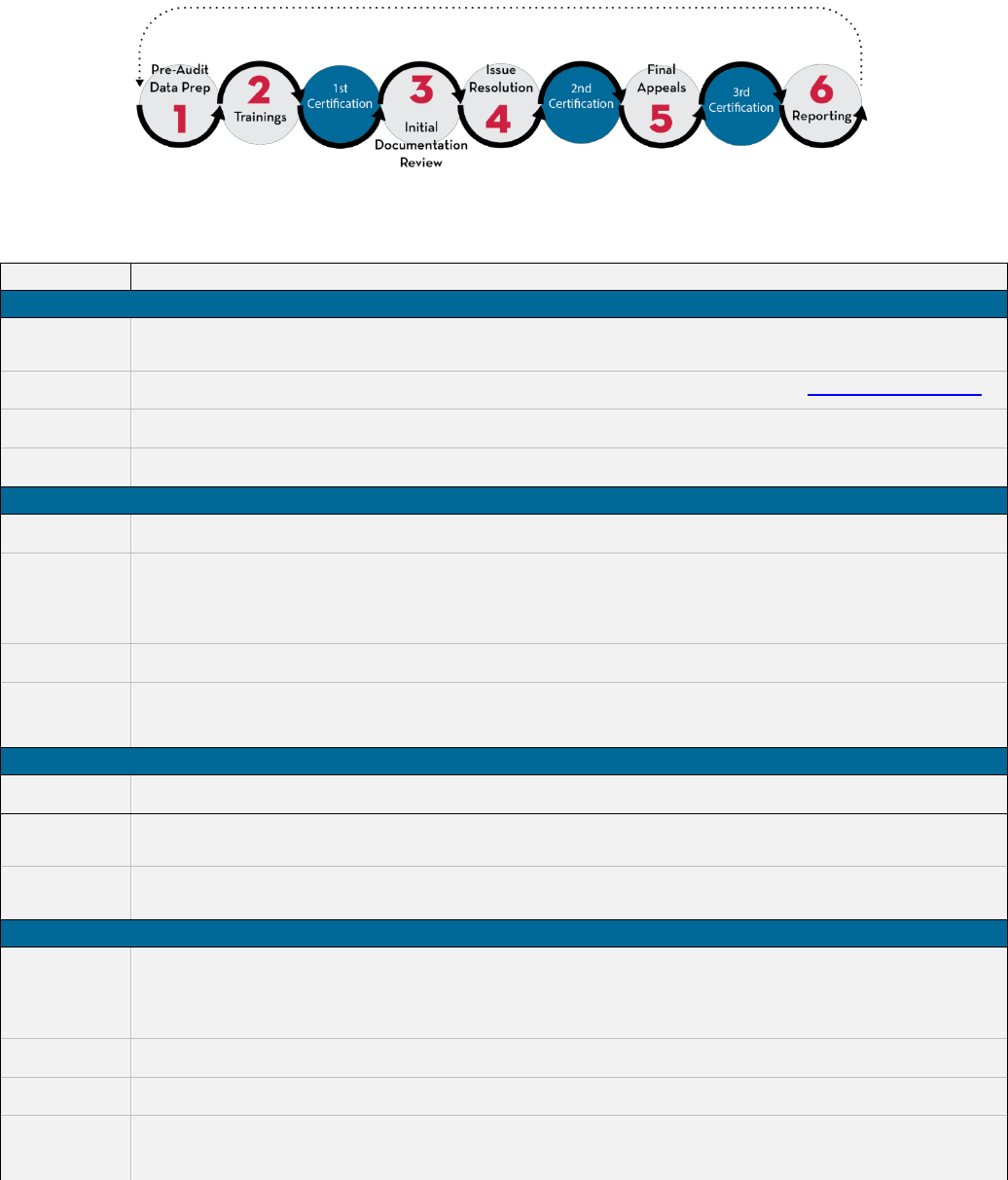
3. Enrollment Audit and Child Count Process Overview
3.1. 2022-23 EACC Calendar
2021 DATE
EVENT/DELIVERABLE
Pre-Audit Data Preparation Phase (Prior to Oct. 5)
April –
September
Pre-Audit Data Preparation Phase: CBOs update data in EACCA
August
CBOs update Enrollment Audit POCs with Division of Early Learning (DEL), at [email protected].
August
Mandatory Enrollment Audit Child Count Training
Ongoing
CBO Pre-K Managers submit changes to CBO name, contact or site directory to DEL
Data Freeze (Oct. 5)
Oct. 5
CBOs ensure all enrolled students are included on the roster by 4 p.m.
Oct. 6 – 11
CBOs review and make final corrections to data in the EACCA for student inclusion/exclusion on
the enrollment roster to ensure annual funding based on the UPSFF; Oct. 11 at 4 p.m. is the final
opportunity for CBOs to submit requests for missing students.
Oct. 11
CBOs must complete all subsidy assignments in the Subsidy Eligibility Assignment (SEA) system
Oct. 12
CBOs submit First Certification (Unaudited Enrollment and Child Count Anomalies
Acknowledgement) in the EACCA. 9 a.m.-5 p.m.
Initial Documentation Review Phase (Oct. 18 – Nov. 12)
Oct. 12 – 24
Appeal window for duplicative enrollment determinations made during enrollment period one
Varies by
CBO*
E-file submission deadline for CBOs participating in a remote Initial documentation review phase.
Varies by
CBO*
Initial Documentation Review: CBOs prepare for auditors to review e-file binders remotely
Issue Resolution Phase (Oct. 20 – Dec. 2)
Varies by
CBO*
Issue Resolution: Initial residency determinations from the remote audit are available for CBO
review in the EACCA. CBOs upload supporting documentation to resolve residency determinations
found during the emote audit.
Oct. 28
Final day for CBOs to submit requests for Demographic Data corrections
Nov. 14
CBOs shall resolve all demographic errors in appropriate source system by 4 p.m.
Nov. 15
CBOs submit the Second Certification (Final Demographic Data Elements) in the EACCA. 9 a.m.-5
p.m.

Final Appeals Phase (Dec. 2 – Dec. 15)
Dec. 2
CBOs submit requests with supporting documentation for final appeals for residency issues in
the EACCA by 11:59 p.m.
Dec. 5 – 6
CBOs receive notification of granted final appeals via the EACCA
Dec. 7 – 9
Final Appeals Phase: OSSE facilitates final appeals for residency
Dec. 14
CBOs can view all final determinations in the EACCA
Dec. 15
CBOs submit Third Certification (Final Audited Enrollment Numbers Certification) in the EACCA.
9 a.m.-5 p.m.
*Phase dates overlap as a collective, but not for individual CBOs. Please see the Enrollment Audit
Workflow Schedule in the EACCA for CBO specific dates.
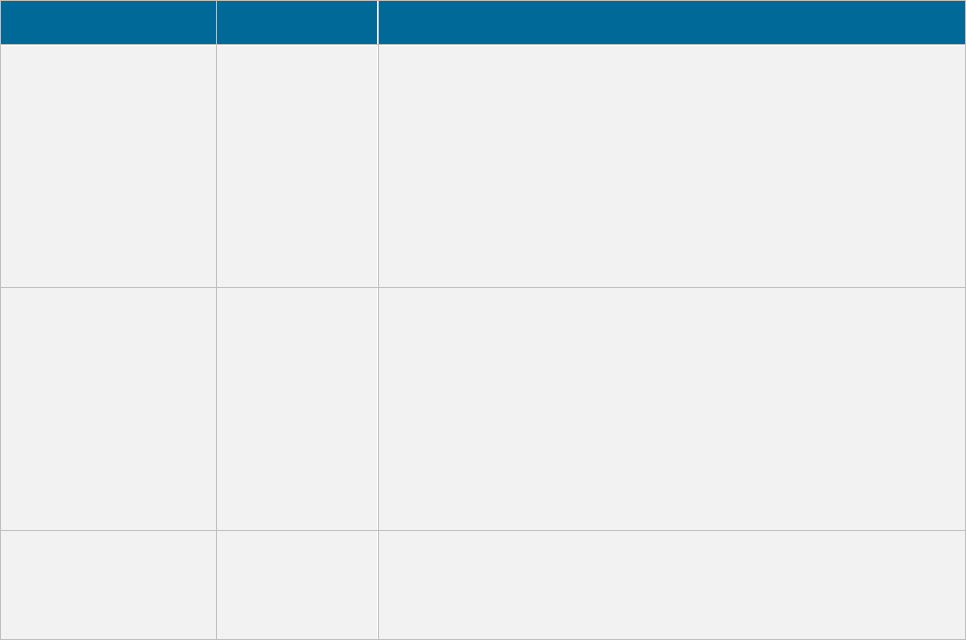
3.2. Enrollment Data Certifications
CBOs shall certify the validity, completeness and accuracy of the CBOs’ data and acknowledge final
enrollment numbers by completing three enrollment audit certifications within the EACCA.
1. The first certification captures the universe of students enrolled in the CBO’s PKEEP classroom,
each of whom should be included in the enrollment audit. The first certification also confirms
that the correct subsidy status is marked for each enrolled student.
2. The second certification certifies that the demographic data (e.g., name, date of birth, address)
for each PKEEP student are accurate, valid and complete.
3. The third and final certification captures the acknowledgment of final enrollment numbers and
demographic information used for funding.
All certifications shall be made by the Pre-K Manager via electronic signature in the EACCA.
Certification Name
2022 Due Date
Purpose of Certification
First Certification
Unaudited
Enrollment and
Subsidy Recipient
Acknowledgement
Oct. 12
9 a.m.-5 p.m.
● CBO acknowledges that enrollment data in the EACCA
includes all students enrolled at the CBO as of Oct. 5
● CBO acknowledges that enrollment data includes accurate
identification of subsidy recipient students
● Failure to complete this certification means that OSSE will
consider the CBO’s Oct. 5, 2022, data to be accurate
through passive approval for the purposes of the
enrollment audit and will utilize that enrollment roster, as
is, for the audit
Second Certification
Final Demographic
Data Elements
Nov. 15
9 a.m.-5 p.m.
● CBO acknowledges that the demographic data for each
PKEEP student in the EACCA are accurate, valid and
complete for all students enrolled at the CBO as of Oct. 5,
2022, (outside of residency and duplicative enrollments);
● Failure to complete this certification means that OSSE will
consider the CBO’s enrollment audit data elements for all
students enrolled at the CBO as of Oct. 5, 2022, to be
accurate, valid and complete through passive approval for
the purposes of the enrollment audit
Third Certification
Final Audited
Enrollment Numbers
Acknowledgment
Dec. 15
9 a.m.-5 p.m.
● Acknowledges the final audited PKEEP enrollment numbers
after the final appeals process is complete.
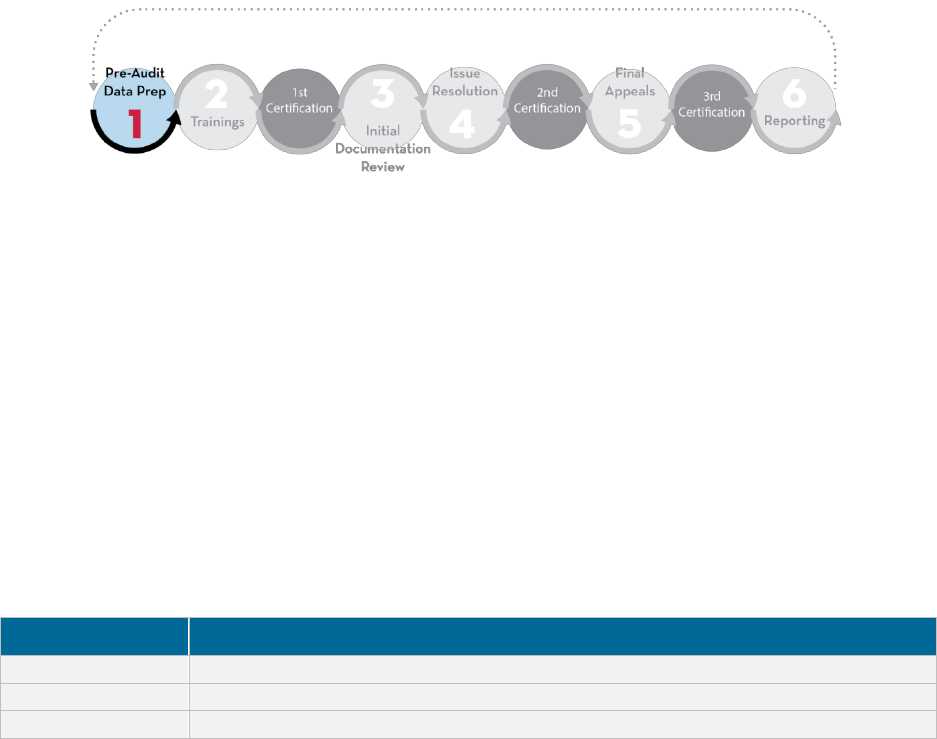
4. Pre-audit Data Preparation
CBOs have from now until Oct. 5 at 4 p.m. to input student records (and edit/update records) to
student enrollment in the EACCA to ensure all students enrolled on Oct. 5 are identified correctly in the
EACCA. CBOs must handle personally identifiable information (PII) of students to complete the
Enrollment Audit and Child Count requirements. The CBO shall follow all applicable Family Education
Rights and Privacy Act (FERPA) laws accordingly.
4.1. Data Quality Terms
All data shall be valid, complete and accurate. Under federal and local law, CBOs are responsible for
maintaining records for data reporting. For the purposes of the enrollment audit, OSSE defines
maintenance of records as:
a) entering accurate data;
b) updating data promptly and accurately upon notification of any changes; and
c) ensuring accuracy so the system of record correctly reflects all students and their environments
under the purview of the CBO.
Term
Definition
Accurate
The data correctly represents reality
Valid
All values entered conform to OSSE-permitted values*
Complete
All required data elements contain values
*OSSE-permitted values can be found in the data elements section (4.4) below.
4.2. Residency Verification
All pre-K 3 and pre-K 4 students for whom a CBO receives PKEEP funds shall be residents of the District
of Columbia. To establish bona fide residency, the person enrolling the students shall demonstrate
compliance with all three of the following requirements, annually:
a) If anyone other than the parent is enrolling the student, establish that they are the valid
guardian, custodian, or other primary caregiver, as set forth in 5A DCMR § 5000 et seq. and
specifically defined in 5A DCMR § 5099, with proper documentation such as a custody order, or
an “other” primary caregiver form;
b) Establish a physical presence in the District, defined as the “actual occupation and inhabitance
of a place of abode with the intent to dwell for a continuous period of time”; and
c) Submit valid and proper documentation that establishes bona fide residency as set forth in 5A
DCMR § 5004. The student residency verification process requires CBOs review documentary
proof of residency during the enrollment period each year (April 1 through Oct. 5). CBOs are
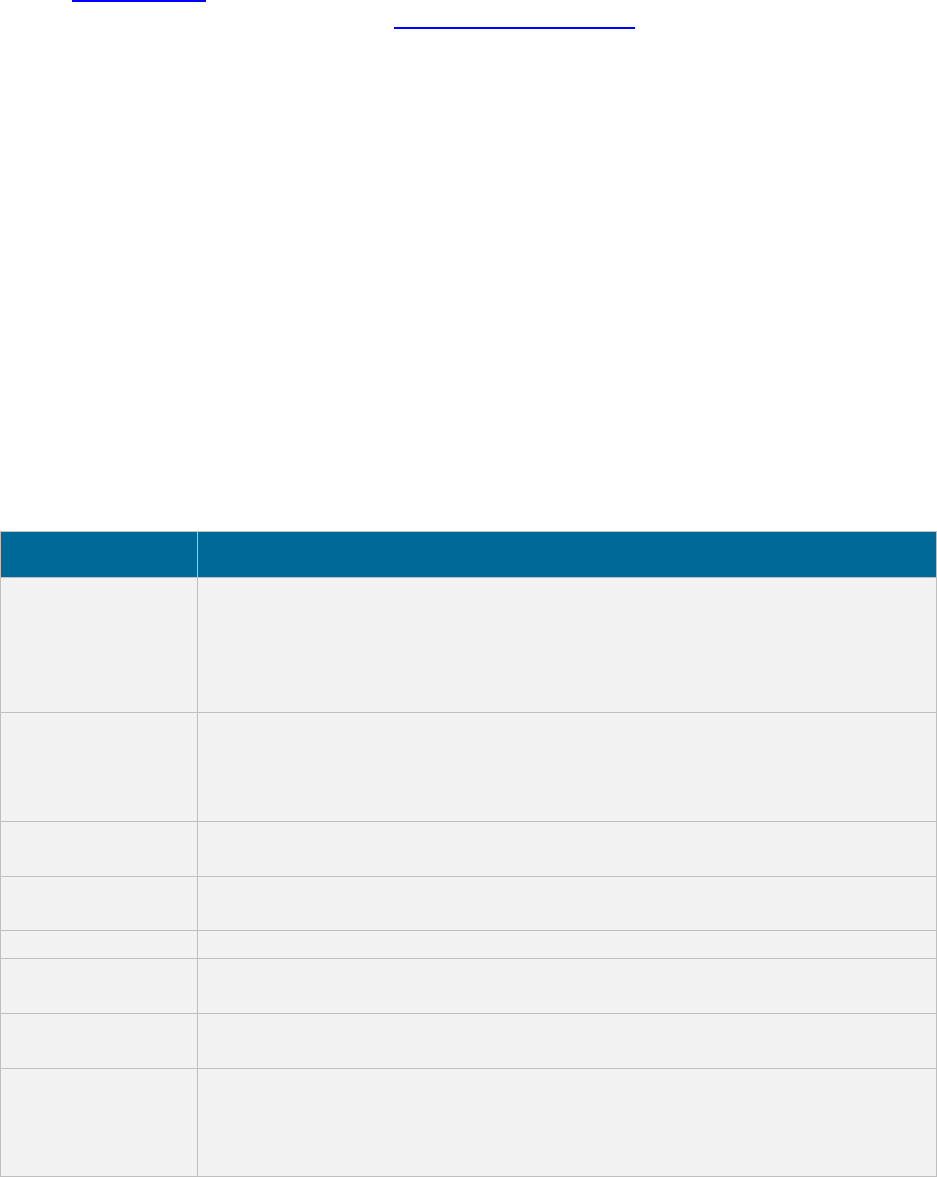
required to review each students’ residency documentation and verify that all documentation
and verification forms are complete, legible and valid prior to Oct. 12, the first certification date.
See the OER Handbook and training for more information on the required residency documentation and
refer to the coronavirus (COVID-19)-related OSSE Guidance Documents for updated guidance on
enrollment and residency verification in response to COVID-19.
4.3. Age Verification
CBOs are required to collect documentation that verifies the student’s date of birth. Pre-K 3 students shall
be 3 years old by Sept. 30, 2022, and pre-K 4 students shall by 4 years old by Sept. 30, 2022.
Acceptable documents for verification of a child’s age include one of the following:
1. A full-size original birth certificate. The birth certificate shall include the name of the parent(s) or
guardian(s) requesting services; or
2. A birth certificate in a non-English language with a certified translation.
4.4. Ensuring Accurate, Complete and Valid Student Records
CBOs shall ensure all students enrolled in the PKEEP are accurately reflected in the EACCA. CBOs have
until Nov. 14, 2022, 4 p.m. to make changes in the EACCA to the data elements listed below. This
ensures student data were entered correctly in the application.
Data element
Definition
Last Name
The legal last name of the student. It is the name carried in common by
members of a person’s family, or the last name recognized as the formal and
content last name given to a person after birth (e.g., birth, baptism or other
naming ceremony certificate; or birth verification document) or through legal
action (e.g., marriage, divorce, adoptions or legal name change).
First Name
The legal first name of the student. It is the name given to an individual after
birth (e.g., birth, baptism or other naming ceremony certificate; or birth
verification document) or through legal action (e.g., marriage, divorce, adoption
or through legal name change).
Date of Birth (DOB)
The day, month and year on which the student was born documented on an
official government certificate.
Street Address
The number and name of the unit and street (and apartment, if applicable)
where the student resides.
City
The city where the student resides.
State
The abbreviation for the state (within the United States) or outlying area in
which the student resides.
ZIP Code
The number that identifies the postal delivery area in the United States in which
the student resides.
Gender
A coded value representing the student’s gender. Gender is a person’s actual
sex or perceived sex and includes a person’s perceived identity, appearance or
behavior, whether that identity, appearance, or behavior is different from that
traditionally associated with a person’s sex at birth.
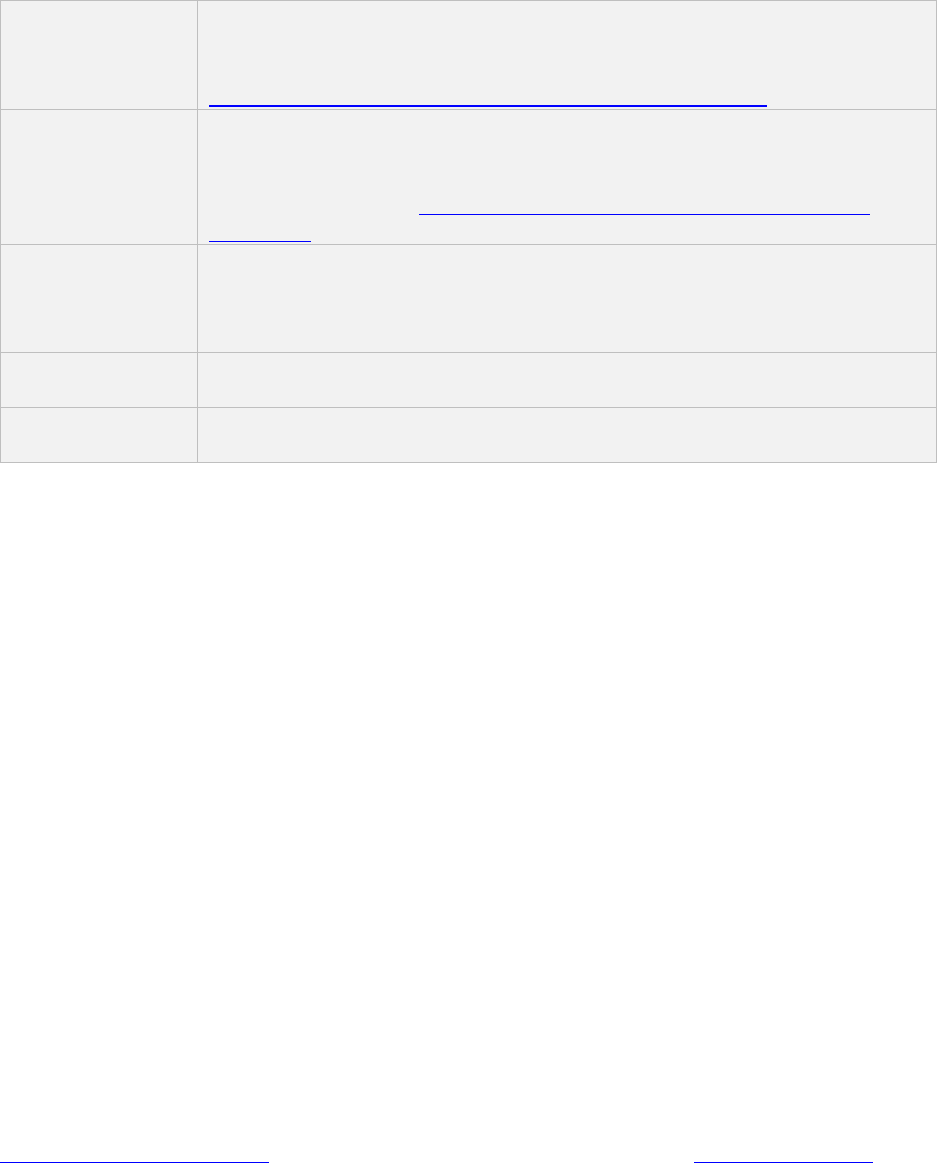
Ethnicity
CBOs are required to categorize student ethnicity as “Yes – Hispanic or Latino”
or “No – Not Hispanic or Latino” for the ethnicity with which the student most
closely identifies. The complete definition of Hispanic and Latino is found in the
OSSE LEA Data Collection Template for the current school year.
Race
CBOs are required to categorize students in one or more of the five permitted
race codes for which race(s) the student most closely identifies. Categories
must be mapped by the CBO to the five federal race values. Definitions of these
values are found in the OSSE LEA Data Collection Template for the current
school year.
Grade Level
The grade level or primary instructional level at which a student enters and
receives services in a school or an educational institution during a given
academic session, as permitted in the EACCA, and aligned to data elements in
Appendix 13.1.
Residency Status
The CBOs determination that the student is or is not a resident of the District of
Columbia based on provided documents to support residency claim.
Homeless
Individuals who lack a fixed (permanent), regular and adequate (acceptable)
nighttime residence; or as defined in McKinney-Vento.
4.5. Enrollment Audit and Child Count Application (EACCA)
The EACCA is the web-based platform for CBOs to enter student enrollment data for the PKEEP
classrooms. This application is used for LEAs and CBOs. “Child Count” only applies to LEAs and is a
federally mandated activity that serves as the official special education enrollment number for the
District of Columbia.
The application allows OSSE to view the individual student records and enrollment rosters throughout
each phase of the audit. Student rosters are created from data pulled from the data the CBO enters
directly into the EACCA. The EACCA:
• Provides a secure method to upload student residency and age verification documentation for
appeals, eliminating the need to upload multiple versions of Excel spreadsheets;
• Allows CBOs to view in near-real time, enrollment student counts as they relate to the
enrollment audit;
• Allows CBOs to view in near-real time, enrollment and residency determinations throughout the
initial documentation review, issues resolution and final appeals phases; and
• Enhances OSSE’s communication to CBOs throughout the enrollment audit phases.
4.6. Technical Assistance
OSSE has assigned CBOs an OSSE CBO Liaison within OER, who can be contacted at
osse.enrollmentaudit@dc.gov. Additionally, the DEL POC can be contacted at [email protected].
4.7. CBO Points of Contact (POCs)
Each CBO is required to have POCs for the annual enrollment audit to handle personal identifiable
information of students; therefore, CBOs shall follow all applicable FERPA laws accordingly.

OSSE will not contact or communicate with CBO staff members beyond the Pre-K Manager and the
designated enrollment audit POC for the enrollment audit. CBOs with multiple staff working on the
enrollment audit are advised to develop a plan for sharing enrollment audit information among their
respective staff members as necessary.
The current list of POCs is available for CBOs to review with the designated OSSE POC. Changes
throughout the school year shall be communicated to OSSE. The Pre-K Manager shall contact the OSSE
CBO POC at [email protected], to submit changes to site information. CBOs should also include
osse.enrollmentaudit@dc.gov on all enrollment audit communications to ensure all relevant staff
receive necessary updates.
POC Type
Description
Pre-K Manager
Responsible for overall management and administration; completes all
certifications for the enrollment audit
CBO Enrollment
Audit POC
Coordinates and manages the enrollment audit, including ensuring deadlines
are met, reviewing data for accuracy and completeness, preparing for site
visits, coordinating documentation, and uploading documents
4.8. Residency Documentation Preparation
All CBOs are required to complete their initial documentation review remotely using the e-file method
of submission through Box. While e-files are due on the e-file due date listed in the EACCA, CBOs will still
be assigned an initial documentation review date that initiates the phases of issue resolution. Details on
these dates will be released with the audit workflow schedule in the EACCA.
4.8.a. Document Preparation for Remote Document Review
CBOs must complete their initial documentation review through a remote documentation review. A
remote document review requires the creation and submission of e-files. For the 2022-23 school
year, OSSE will use Box as the platform for providing the e-files. The EACCA will have a link directly
to the school folder in Box for uploading enrollment audit e-files. The e-files must contain the
required documentation for all enrolled students.
Location of E-file Folder for Upload
1. CBOs have several folders within Box, relevant to different purposes with OSSE. The e-file uploads
should be uploaded to the CBOs Box folder named “Enrollment Audit E-file.”
2. Box access will be based on the CBO Enrollment Audit POC role. CBOs must ensure the
appropriate staff member(s) are assigned as the CBO Enrollment Audit POC provided by DEL in
the Pre-Audit Phase.
File Organization
1. Organize the DCRV form and all applicable residency verification forms and supporting residency
documentation (i.e., OPC Form) into 15 GB (max) .pdf files.
2. Folders and files should be created and loaded into the Enrollment Audit Box folder in the
following order:
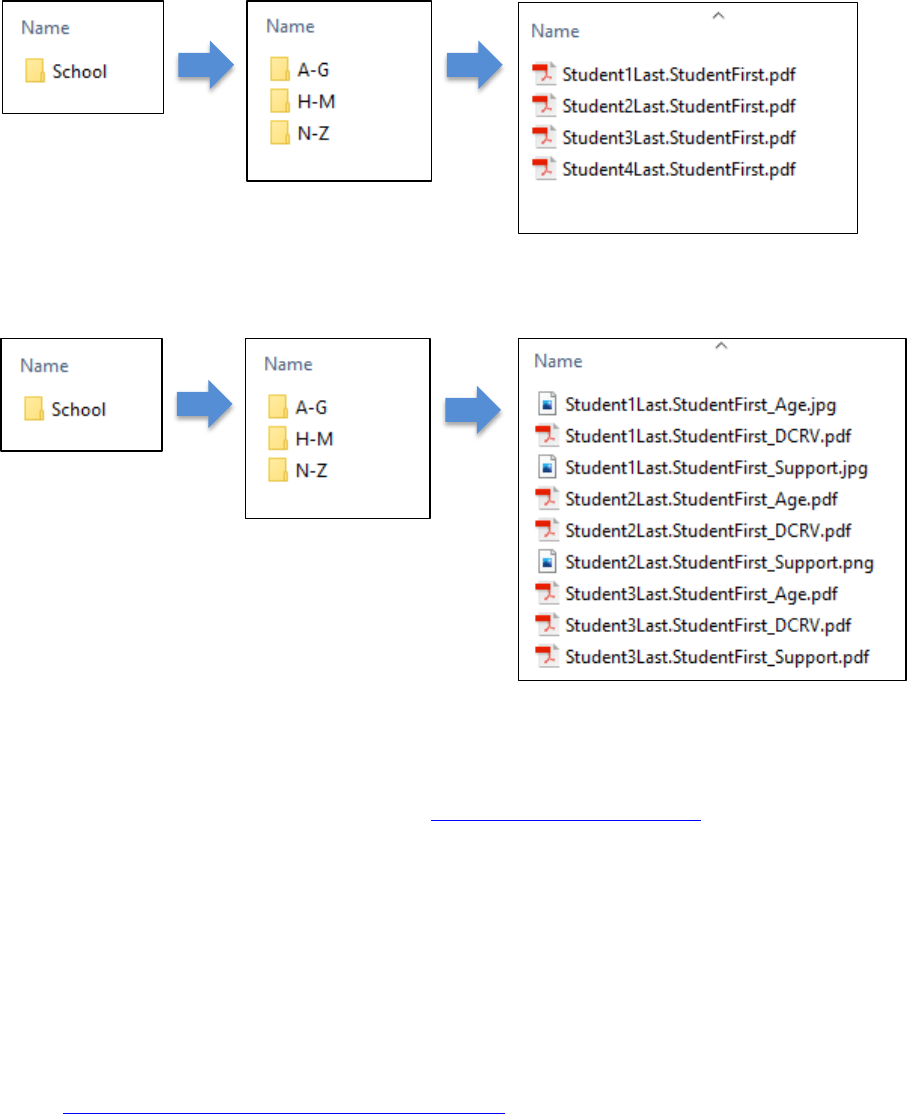
▪ School folder
▪ Group by last name folder
▪ Student last name, student first name file(s)
3. The document uploads can be either a single document containing both residency forms
supporting residency documents, and age verification documents; or
Three separate documents - one for the residency forms, one for supporting residency documents, one
for age verification.
Alternatives for E-file Preparation
CBOs may request an alternative folder or file structure to the e-file preparation requirements. To
initiate this process, the CBO should reach out to osse.enrollment[email protected]. Any request for
change to the e-file preparation shall be done in consultation with the CBO and auditor and only
approved if OSSE and the auditor are able to support the change.
4.9. Box Folder Preparation
Box folders are used annually, so they may contain empty folders of students from prior enrollment
audits. CBOs shall remove student folders from prior years. Removing the folders ensures an auditor
reviews the correct folders for the correct student.
If a CBO experiences issues while uploading documents or experiences file and folder constraints, they
may review Appendix C: Box Constraints and Troubleshooting for additional guidance.
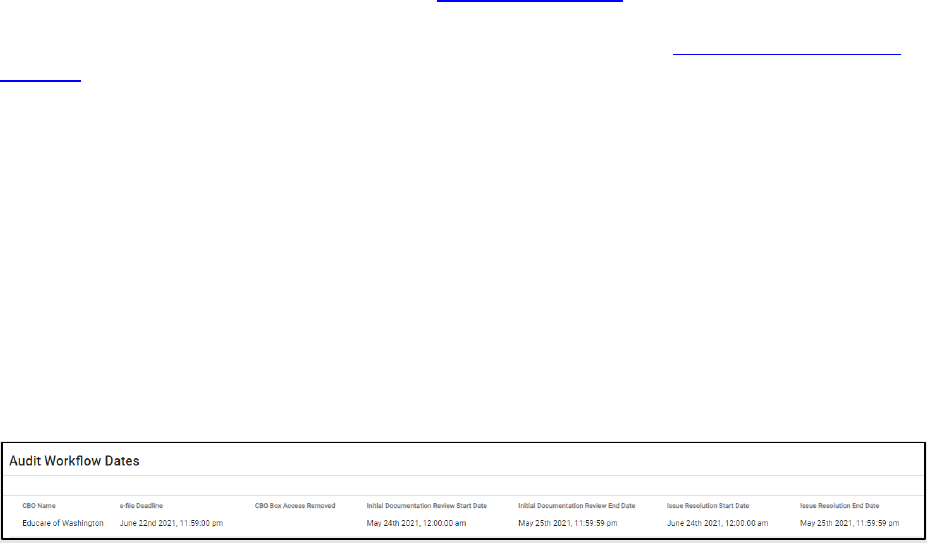
4.10. CBO E-file Submission
CBOs shall upload all residency forms and supporting residency documents to Box by their CBO e-file
deadline. The e-file deadline can be found in the audit workflow table at the bottom of each CBOs
EACCA dashboard. CBOs can access Box Enrollment Audit folders by logging into Box directly or selecting
the e-file submission button in the EACCA. Uploads shall be compliant with residency documentation
guidance outlined in this handbook.
Failure to upload residency forms and documents by the e-file deadline may result in the CBO having to
appeal all students through the issue resolution process - a manual upload for each individual student.
E-file is only used during the initial documentation review phase. Subsequent actions and appeals are
completed directly in the EACCA, at the student level.
4.11. Audit Workflow Scheduling
The audit workflow lays out each CBO’s timeline for completing the enrollment audit. Audit workflow
schedules are uploaded into the EACCA in August. The CBO is responsible for reviewing the dates listed
in the audit workflow table and ensuring all deadlines are met.
*Note: This is an example and not real dates for the audit.

5. Enrollment Audit Trainings
To ensure that CBO Enrollment Audit POCs have a strong understanding of any policy or process changes
regarding the yearly enrollment audit, OSSE hosts several trainings in advance of the initial
documentation review phase targeted toward the CBOs’ Enrollment Audit Point of Contact (POC). CBOs
shall send at least one participant for EACCA trainings. OSSE may inform the Pre-K Manager if no
representative from their CBO attends the training.
5.1. Enrollment Audit Child Count Application Training
The EACC portion of the training aims to inform CBO Enrollment Audit POCs on the enrollment audit, its
web-based application, purpose, and timeline. The EACCA portion of the training aims to inform CBO
Enrollment Audit POCs on the key application relevant to the enrollment audit. The training is a
collaborative effort between OER and the Office of the Chief Information Officer (OCIO). The training
involves technical guidance and processes necessary to successfully navigate the enrollment audit. The
training will include Box functionality, guidance to avoid errors when uploading student records and
steps to troubleshoot prior to submitting a request for technical support from OSSE. All enrollment audit
POC’s are encouraged to attend the training session each school year.

6. First Certification: Unaudited Enrollment Certification
The first certification of data is crucial to each CBO’s success in the enrollment audit. It is the best time
to flag any data issues and ensure all PKEEP students are accurately listed in the EACCA. The key dates
and actions are:
Oct. 5 at 4 p.m.
OSSE freezes enrollment data submitted by CBOs.
Oct. 6 through Oct. 11 at 4 p.m.
CBOs review their data in the EACCA to ensure that all students enrolled in the PKEEP classroom(s) as of
Oct. 5 are accounted for on the roster. This includes:
• Resolving duplicative enrollment with another CBO or LEA;
• Making corrections to student records in the EACCA to ensure all demographic data for students
enrolled in PKEEP are accurate; and
• Reviewing and confirming that all subsidy recipients are correctly identified.
After Oct. 11
CBOs cannot add additional students to the enrollment audit roster under any circumstances after 4
p.m. on Oct. 11, 2022. It is critical that the CBO ensures that all students for whom the CBO seeks
PKEEP funding, based on the fiscal year 2023 projected enrollment (i.e., attending as of Oct. 5) are on
the enrollment audit roster in the EACCA.
Oct. 12 at 5 p.m.
Pre-K Managers shall complete the first certification in the EACCA between 9 a.m. and 5 p.m.
6.1. Amending the Unaudited Enrollment Roster after First Certification
CBOs are responsible for certifying accurate, complete and valid student data. In the event the data
certified is incorrect, the CBO shall complete the following steps to resolve.
Adding a Student
If a CBO determines that a student should be added to the PKEEP student roster in the enrollment audit
Child Count application, the CBO should complete the below steps.
1. CBO submits request to DEL POC, [email protected], to add missing student(s) into the EACCA
2. DEL POC acknowledges receipt of the request, and the COB submits the below data elements for
the requested students through the CBOs Box portal
3. The request should include:

a. The date the student enrolled in the PKEEP classroom
b. Explanation for why the student was not included in the data capture
c. Student information - first name, last name, USI and DOB
d. Submitted in a .pdf format
4. CBO contacts the DEL PKEEP POC at [email protected] to confirm that the student record(s)
was submitted in Box
5. OSSE sends CBO notification indicating that the request is accepted, rejected, or to request
additional information
Removing a Student
If a CBO determines that a student should be removed from the PKEEP student roster in the enrollment
audit child count application, the CBO should complete the steps below. Please note that OSSE’s OCIO
team will process requests.
1. CBO submits request to DEL POC, [email protected], to remove student(s) from the EACCA
2. Once the DEL POC acknowledges receipt of the request, the CBO will submit the data elements
below for the requested students through the CBO’s Box portal in a pdf.
3. The request should include:
a. The date the student unenrolled from the PKEEP classroom
b. Student information - first name, last name, USI and DOB
c. Submitted in a .pdf format
4. CBO contacts the DEL PKEEP POC at [email protected] to confirm that the student record(s)
was submitted in Box
5. OSSE sends CBO notification indicating that the request is accepted, rejected, or to request
additional information
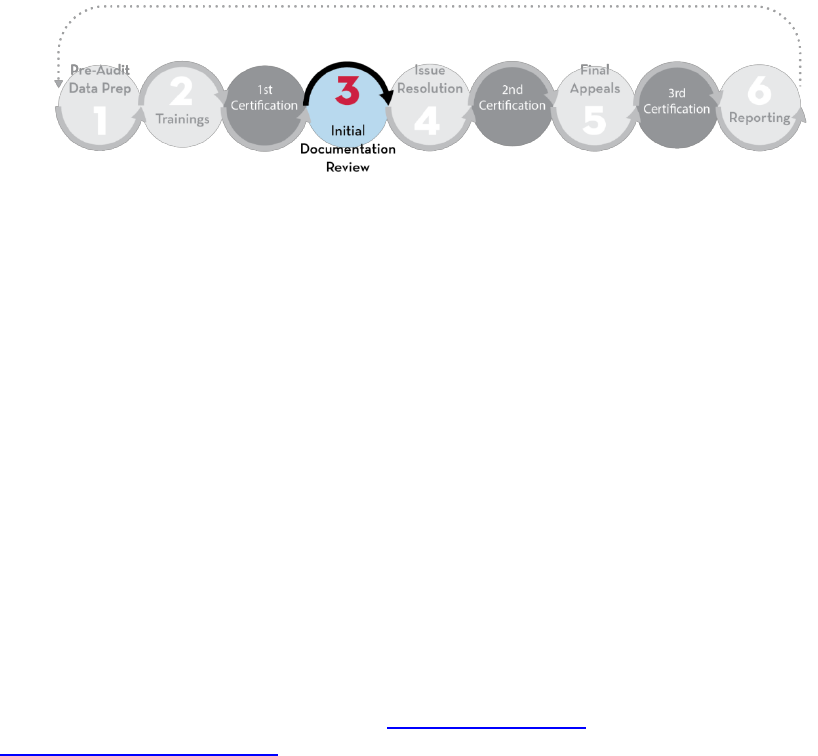
7. Initial Documentation Review
The initial documentation review phase of the enrollment audit is the process wherein OSSE auditors
review residency documentation remotely. All CBOs will be assigned an initial documentation review
date. This date is when the auditors will begin remote review of documentation and recording of
determinations. It is also the start date for all subsequent follow-up requirements to be completed by
the CBO. At the conclusion of the remote document review, the CBO will be able to view initial
documentation review determinations in the EACCA.
7.1. Enrollment Audit Initial Documentation Review Scope
OSSE auditors will review every student’s DC Residency Verification form (DCRV) as well as any
supporting residency forms when applicable (Other Primary Caregiver form, sworn statement, etc.).
OSSE’s review of supporting residency documentation will depend on whether an individual PKEEP
student participates in the District’s subsidized child care program.
Non-Subsidy Students
Students who do not participate in the District’s subsidized child care program shall have a completed
DCRV form, valid supporting residency and age verification documentation. Information on valid
supporting documentation can be found in the Residency Verification section of this handbook and on
the OSSE Enrollment Audit website. If the supporting documentation is ultimately rejected by the
auditor, that student will be counted as an unverified resident or flagged for an age error and the CBO
will not receive funding for that student.
Subsidy Students
Students who participate in the District of Columbia’s subsidized child care program will only need a
completed DCRV form and do not need to provide valid supporting residency documentation. These
students must be accurately identified by the CBO. The CBO must complete all subsidy assignments in
the SEA system by Oct. 11.

8. Issue Resolution
During the issue resolution phase, CBOs shall respond to auditor rejections from the initial document
review phase. Depending on the issue or rejection, CBOs shall respond to auditors and OSSE as promptly
as possible during this period to ensure timeliness of data reconciliation through Box, phone, email and
the EACCA.
8.1. Issue Resolution Response
The timeline for responding to an issue is CBO-specific and outlined in the EACCA Audit Workflow Table.
Each CBO shall be responsible for reviewing their issue resolution timeline and ensuring all deadlines are
met. CBOs can review the residency and age verification status of each student in the EACCA at the start
of their issue resolution phase. The issue resolution timeline will not follow the strict business day
counts used in prior enrollment audits. The auditor review time may be different depending on CBO
enrollment size and the enrollment sizes of other CBOs scheduled on the same day. However, CBOs will
have five business days during issue resolution to respond to all auditor determinations from the initial
document review phase.
When responding to the auditor findings, the uploaded documentation must demonstrate the student’s
bona fide District residency. See the OER Handbook for information on required residency
documentation.
The documents are then reviewed by OSSE auditors and a second determination is rendered and
documented in the EACCA. If the CBO does not agree with determinations rendered during the issue
resolution phase, a request for a final appeal must be made using the EACCA by Dec. 2, 2022, 11:59 p.m.
If appealing, CBOs must upload documentation to resolve the student’s residency status directly in the
EACCA by Dec. 2, 2022.
If a CBO fails to respond to a student’s non-residency status by the close of the issue resolution response
period, the CBO cannot submit a final appeal for the student’s residency determination. OSSE considers
the residency determination final for students without an issue resolution response from the CBO as
acceptance of the auditors’ decision.
If the CBO fails to attempt to resolve the student’s residency status during the issue resolution phase, a
letter of exception must be submitted to OSSE documenting the missed resolution period within five
business days of the missed resolution period. Even if a letter is submitted, the decision to allow the
exception remains with OSSE. The letter can be sent via email to osse.enrollmentaudit@dc.gov.
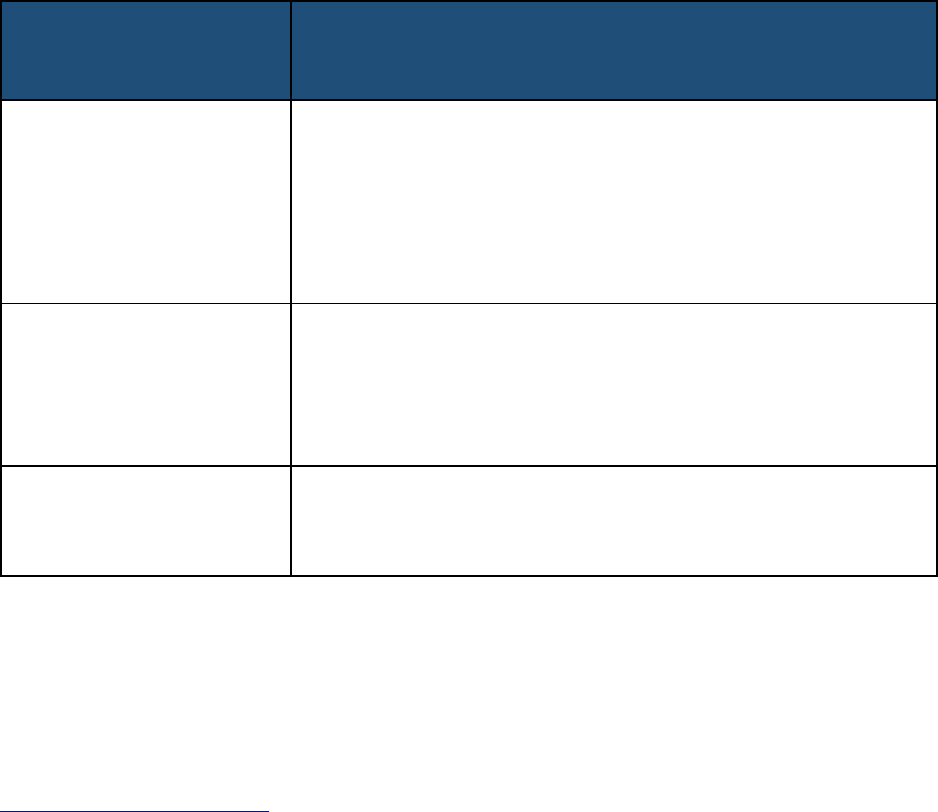
8.2. Duplicative Enrollments
If a student is enrolled in more than one CBO or LEA, OSSE will use documentation from the CBOs and
attendance records to make an enrollment determination. To resolve a duplicative enrollment, CBOs are
required to submit all applicable documentation listed in the hierarchy tables below through the EACCA
by Oct. 24, 2022. OSSE will evaluate the documents using the hierarchy order identified below to make a
determination.
OSSE will first consider the documentation shared within the first level of the hierarchy identified below.
If this documentation does not provide clear and convincing evidence of the student’s enrollment for
the current school year, then OSSE will consider the totality of the documentation shared in the first and
second levels of the hierarchy. If this documentation does not provide clear and convincing evidence of
the student’s enrollment for the current school year, then OSSE will consider the totality of the
documentation shared in the first, second and third levels of the hierarchy and make a final
determination.
Hierarchy order for
Duplicative Enrollment in a
CBO and an LEA
Acceptable Documentation
1. Enrollment/Withdrawal
Forms
The CBO shall provide current school year enrollment or withdrawal
documentation signed by the parent/guardian. The documentation
should identify the date the student entered or exited the program
and include signatures from the enrolling parent/guardian and a
program official. Additionally, if available, the program should
provide the Request for Student Records or confirmation from the
receiving CBO verifying enrollment or withdrawal.
2. Attendance/Discipline
Records
OSSE will review attendance records from Sept. 28 through Oct. 26.
For CBOs with an intersession break scheduled during the specified
time period, an equivalent number of days for in-school attendance
will be added to the end of the stated time. Additionally, if available,
the CBO should submit Discipline Records and/or Unusual Incident
Report (UIR) for this stated time period.
3. Schoolwork
The CBO shall submit two pieces of schoolwork or exam
documentation that include the student’s name, in the student’s
handwriting where possible, and the date of the work from Sept. 28
through Oct. 26.
8.3. Demographic Data Elements
Demographic data entries for students must be entered directly into the EACCA. For resolving issues
with demographic data elements, CBOs must confirm all student demographic data is correct in the
EACCA.
If a CBO is unable to fix a demographic issue, an email request should be sent to
osse.enrollmentaudit@dc.gov describing the technical issue the CBO has incurred. All enrollment audit
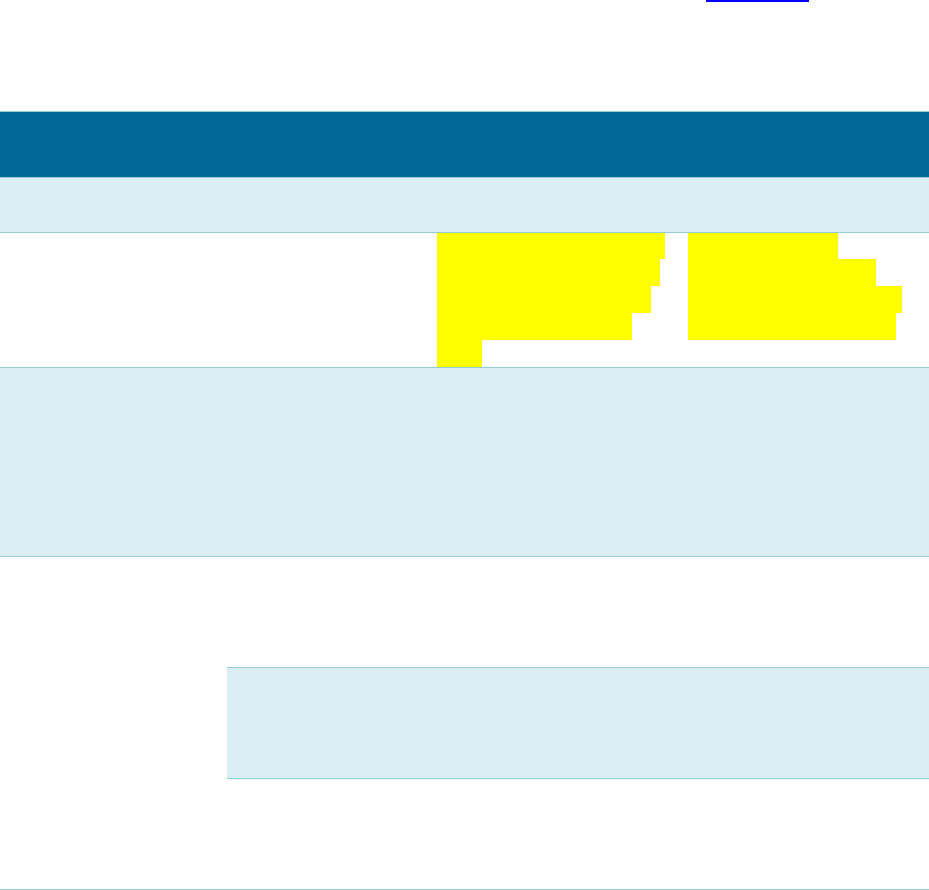
technical issue requests must be submitted by CBOs no later than Oct. 28, 2022 to ensure adequate
time for OSSE to respond before the end of the issue resolution phase.
CBOs have until Nov. 14, 2022 at 4 p.m. to resolve and correct data directly in the EACCA. CBOs may
submit questions about data values for specific students and request support from OSSE on resolving
data errors and anomalies through the Box request, particularly for data elements that come from other
District agencies.
The following table lays out the data elements tested during the audit and the pathways for resolving
errors in the student record during the issue resolution phase. (Please also see Appendix A for a full list
of all data elements used in the enrollment audit and their source systems). OSSE recommends resolving
errors as quickly as possible within the issue resolution period to make sure all necessary changes from
the source system to the EACCA are accurately reflected.
Resolving Demographic Conflict After Second Certification
Audit Category
Audited data
element
Initial Enrollment Audit
Determination
Resolution Path for CBO
DC Residency
Residency status
OSSE auditor via site visit
Provide corrected
residency documents
Duplicative
Enrollment Across
CBOs and LEAs
Duplicative
Enrollment
OSSE determination after
receiving documentation
from CBOs, if applicable
prior to or on Oct. 24,
2022
Provide required
duplicative hierarchy
documentation to claim
the student as enrolled
Student Demographic
Information
Name;
Date of Birth;
Address;
Gender;
Ethnicity;
Race;
Grade
CBO uploads into EACCA
No appeal - data
corrected through EACCA
by Nov. 14, 2022
At-risk
Homeless
CBO entry of homeless
at-risk indicator
No appeal– data
corrected through EACCA
during issue resolution
phase by Nov. 14, 2022
SNAP/TANF
DC Department of
Human Services (DHS)
feed
No appeal – CBO submits
Box request to resolve
inconsistencies by Oct.
28, 2022
Under the care of
CFSA
DC CFSA feed
No appeal – CBO submits
Box request to resolve
inconsistencies by Oct.
28, 2022

In the event a CBO has completed all the steps in the table above and has been unable to fix the
demographic issue(s) after second certification, a request must be submitted via Box, including the CBO
Data Template with the relevant data fields completed.
After the request is submitted, the CBO must email [email protected]v and
osse.enrollmentaudit@dc.gov to provide notification of the request.

9. Second Certification: Final Demographic Data Elements Certification
CBOs shall submit the Second Certification (Final Demographic Data Elements Certification) directly in
the EACCA no later than 5 p.m. (EST) on Nov. 15, 2022.
Through the second certification, the CBO acknowledges that the Nov. 14 student demographic data
entered in the EACCA are accurate, valid and complete (outside of residency and duplicative
enrollment).
Failure to complete this certification means that OSSE will consider the CBO’s data to be accurate
through passive approval for the purposes of demographic data (excluding disputed residency and
duplicative enrollment determinations) for the enrollment audit and will utilize that enrollment roster,
as is, for the audit.

10. Final Appeals
If the CBO disagrees with OSSE’s determination of residency, the CBO can request a final appeal through
the EACCA. All requests for final appeals for residency status must be received by 11:59 p.m. on Dec.
2, 2022. Technical instructions can be found in the EACCA CBO User Guide located under the EACCA
menu.
If the CBO does not respond to an auditor’s decision during issue resolution, the auditor’s decision is
final and the opportunity for a final appeal is forfeited. If the CBO does respond to an auditor’s decision
during issue resolution, but is not successful in resolving, a final appeal can be submitted.
10.1. Final Appeal Submission
Final appeal submissions are processed through the EACCA. To submit a final appeal to resolve residency
determinations, CBOs must have:
1. Attempted to resolve the residency determination during the issue resolution phase;
2. Submitted additional supporting documentation that verifies the student’s District residency
status by 11:59 p.m. Dec. 2, 2022; and
3. Uploaded compliant residency documentation for review. It is strongly suggested that CBOs
submit documentation as soon as corrected/updated documentation is available for upload in
the EACCA.
OSSE reviews all documentation submitted for the student during initial documentation review, issue
resolution and final appeal. If upon review, the student’s documentation is approved, the status is
updated in the EACCA. If OSSE cannot approve the documentation provided, OSSE may follow-up with
the CBO or schedule a meeting to review unique cases. If time allows, OSSE may provide instructive
comments on the student record on how the CBO may resolve any outstanding issues. CBOs should
review the student-level comments section regularly.
The outcomes of final appeals are updated in the EACCA prior to the final certification. The decision
from the final appeal is irrevocable. CBOs are able to view all final determinations by Dec. 14, 2022.

11. Third Certification: Final Audited Enrollment Numbers
Acknowledgement
The third certification shall be completed by the CBO Pre-K Manager POC via electronic signature in the
EACCA. The CBO Pre-K Manager shall confirm the final audited enrollment numbers no later than 5 p.m.
on Dec. 15, 2022. This certification ensures that CBOs have received and reviewed the outcome of the
2022-23 school year enrollment audit.
If a CBO does not confirm the final, audited enrollment numbers by the deadline, additional follow up
may be conducted directly with the Pre-K Manager.

12. Reporting
After receipt of the third and final audited enrollment certification, OSSE produces and disseminates the
final enrollment audit report in January 2023.

13. Appendices
13.1. Appendix A: 2022-23 Enrollment Audit Data Elements
Category
Data Element
Definition
Source
System
Permitted Values
Student
Demographic
USI
The official state identifier
for all students attending a
District of Columbia high-
quality pre-k program;
assigned by OSSE.
Enrollment
Audit and
Child Count
Application
10-digit numeric
Student
Demographic
Local ID
A unique number of
alphanumeric codes
assigned to a student by
the CBO.
Enrollment
Audit and
Child Count
Application
Alphanumeric
Student
Demographic
Last Name
The legal last name of the
student.
Enrollment
Audit and
Child Count
Application
Alpha
Student
Demographic
Middle Name
The legal middle name of
the student.
Enrollment
Audit and
Child Count
Application
Alpha
Student
Demographic
First Name
The legal first name of the
student.
Enrollment
Audit and
Child Count
Application
Alpha
Student
Demographic
Date of Birth
The day, month, and year
on which the student was
born.
Enrollment
Audit and
Child Count
Application
Numeric - mm/dd/yyyy
Student
Demographic
Gender
A coded value representing
the student’s gender;
gender is a person’s actual
sex or perceived sex.
OSSE
Authoritative
F – female
M – male
X – non-binary
Student
Demographic
Ethnicity
An indication that a
student identifies as
Hispanic or Latino.
Enrollment
Audit and
Child Count
Application
H – Hispanic/Latino;
N – not Hispanic/
Latino
Student
Demographic
Race
CBOs are required to
categorize students in one
or more of the permitted
race categories.
Enrollment
Audit and
Child Count
Application
AS – Asian
BL – Black/African
American
AM – American
Indian/Alaskan Native
PI – Pacific

Islander/Native
Hawaiian
WH – White/Caucasian
Student
Demographic
Student
Street
Address
The number and name of
the unit and street (and
apartment, if applicable)
where the student resides.
Enrollment
Audit and
Child Count
Application
Alphanumeric
Student
Demographic
Student City
The city where the student
resides.
Enrollment
Audit and
Child Count
Application
Alpha
Student
Demographic
Student State
The abbreviation for the
state (within the United
States) or outlying area in
which the student resides.
Enrollment
Audit and
Child Count
Application
Two-letter standard
state abbreviation
Student
Demographic
Student ZIP
Code
The number that identifies
the postal delivery area in
the United States in which
the student resides.
Enrollment
Audit and
Child Count
Application
5-digit or 5+4-digit
numeric
Student
Demographic
Student Ward
Student's ward of
residence for students
residing within the District
of Columbia.
Generated
by the DC
Master
Address
Repository
(MAR) based
on CBO
reported
Student
Street
Address,
Student City,
Student
State and
Student ZIP
Code
1, 2, 3, 4, 5, 6, 7, 8
Program
information
Ward of State
Indicator
An indication that the
student is under DC foster
care.
Populated by
OSSE using
data
provided by
CFSA
Yes – the student is
under the care of the
District's foster care
system
No – the student is not
under the care of the
District's foster care
system
Program
information
At-Risk
Indicator
An indication that the
student is homeless, in the
District’s foster care
system, qualifies for TANF
Derived by
OSSE based a
student
having at
Yes – the student is
considered at-risk
No – the student is not
considered at-risk

or SNAP, or that the high
school student is one or
more years older, than the
expected age for the CBO-
identified grade level.
least one
indicator
Program
information
Homeless
Indicator
An indication that the
student is experiencing
homelessness.
Enrollment
Audit and
Child Count
Application
and
populated by
OSSE based
on data
received
through
homeless
data feeds
(TCP)
Yes – the student has
been identified as
homeless
No – the student has
not been identified as
homeless
Student
Enrollment
CBO-
Identified
Grade Level
The grade level or primary
instructional level at which
a student enters and
receives services in a
school or an educational
institution during a given
academic session.
Enrollment
Audit and
Child Count
Application
PK3 – Pre-kindergarten
(3-year-olds)
PK4 - Pre-kindergarten
(4-year-olds)
Student
Enrollment
UPSFF Grade
Level
The translation of the
student's CBO-identified
grade level to the UPSFF
weighting according to the
student's CBO-identified
grade level.
Derived by
OSSE using
CBO
identified
grade level
and special
program
designations;
students
with missing
or invalid
CBO
identified
grade levels
PK3 – Pre-kindergarten
(3 years old by Sept.
30)
PK4 – Pre-kindergarten
(4 years old by Sept.
30)

are placed
into age-
appropriate
grades
Student
Enrollment
Entry Date
The month, day and year
on which the student
enters and begins to
receive instructional
services in a school or an
institution during a given
school year.
CBO
Numeric - mm/dd/yyyy
Student
Enrollment
Duplicative
Enrollment
Indicator
An indication that the
student is enrolled at more
than one school and/or
CBO.
Derived by
OSSE based
on the
student's
school of
enrollment
and USI in
the daily
data feeds
Yes – the student is
currently enrolled at
multiple schools
No – enrolled at only
one school

13.2. Appendix B: Additional Resources
Title
Location
Enrollment Audit and Child
Count policy questions
Email: Osse.enrol[email protected]v
Office of Enrollment and
Residency Handbook
osse.dc.gov/node/1525206
EACCA Credential Support
To request access or reset your EACCA password, email
sled.osse.dc.gov
13.3. Appendix C: Box Constraints and Troubleshooting
The following guidance is for CBOs experiencing upload or file format issues when utilizing Box for their
e-file upload.
File Type Constraints
Box Drive will not sync files that the program ignores or blocks. Ignored files include those that are
invisible in Windows Explorer or Finder, such as temporary or system files. Blocked files include file
types that Box Sync or Box Drive does not recognize. Box Sync still requires read permissions on these
files in order to determine if the file should be blocked or ignored during the scanning process.
Preferred File Types:
• .pdf
• .jpeg
• .jpg
• .png
Box Drive ignores or deletes the following file types and shortcuts which can also cause an error:
• Temporary files and folders (.tmp and files starting with the ~ character)
• Backup copies of files (.bak)
• System and hidden files (hidden folders are synced but hidden files are not synced: such as
._dstore, desktop.ini, thumbs.db)
• File names that start with a dot "." are considered hidden files
• Hiding any file or folder in Sync also deletes that content
• Shortcuts created via Windows Explorer or Finder
• Hard links (a file that has multiple directory entries associated with it will not be synced)
• Symbolic links
• Shortcuts created via Windows Explorer or Finder (.lnk)
• File names that are exactly eight uppercase hexadecimal digits (0,1,2,3,4,5,6,7,8,9,A,B,C,D,E, or
F) with no extension – for example: 1234AD38 or ABE32BD0
• File names containing special characters
• Web based documents (such as .gdoc, .gsheet, and bookmarks) will not sync to the Box Drive
folder
• .qbi files
While the following file types can be uploaded and stored in Box via the Box website, Box Sync will not
recognize them. They will not be synced even if they are in a synced folder. Box Drive blocks the
following file types:
• .pst
• .qbw
• .nd
• .qbw.tlg
• .tlg
• .des
• .qba
• .qba.tlg
• .qbr
• .qby
• .qdt
• .pdx
Due to the saving behavior of Microsoft Access, it's likely that Box Drive will create duplicate copies of
.accdb and .mdb files. Even one user working on a file can cause conflicting copies due to how
frequently Access makes changes to the database file. Box Drive users can copy the file out of the Box
folder and copy the file back into the Box folder after the changes are made to upload the changes to
Box.
Box Drive does not support (.app) Mac package files. You will see an error from Finder if you attempt to
copy a package file into Box Drive. Package files uploaded by Box Sync will appear as problem items in
Box Drive.
Folder Name Constraints
Some operating systems do not support item names containing some special characters. If you attempt
to sync files or folders names containing these characters, Box Sync prompts you to rename the item
using the underscore character.
Box does not support "/" and "\" anywhere in a file or folder name or whitespaces at the beginning or
end of a file or folder name.
Windows OS has additional restrictions. The following won’t be supported:
• < (less than)
• > (greater than)
• : (colon)
• " (double quote)
• / (forward slash)
• \ (backslash)
• | (vertical bar or pipe)
• ? (question mark)
• (asterisk)
In addition, Windows does not support folder names that end with a . (period) character. If Windows
does not support certain characters in file or folder names, Box marks them as problem files.
Similarly, Mac OS has additional restrictions. The following won’t be supported:
• opening spaces
• Mac’s character conversion in file names (for example, Mac changes any occurrence of/to in file
names).
If Mac does not support certain characters in file or folder names, Box marks them as problem files.
Contact Apple support for recommendations on renaming files, folders or disks.
If the item on Box has an unsupported name, rename the item on Box and Box Drive will re-process the
download. If the local file has an unsupported name, rename the file locally.
File Size Constraints
The maximum file size limit for individual uploads to Box Enterprise is 15 GB. To confirm the file size limit
for your account, log into Box. In the upper – right hand corner, click your account icon. From the menu
that displays, click Account Settings. On the page that displays, scroll down to the Account Details
section. Your max file size is listed in this section. You will have an Enterprise file size, with respect to
OSSEs Box account, which is an Enterprise Account.
Troubleshooting Uploads to Box
If you are having trouble uploading files or folders, please try the following troubleshooting steps:
• Ensure your web browser is the latest version of Internet Explorer, Safari, Firefox or Chrome.
• Try clearing your browser's cache.
• Verify that you are using one of the recommended operating systems.
• Verify that the file's name is valid. Box only supports file or folder names that are 255 characters or
less. File names containing non-printable ascii, "/" or "\" names with leading or trailing spaces, and
the special names “.” and “..” are also unsupported. Box supports only Unicode Basic Multilingual
Plane (BMP) characters in file and folder names.
• Verify that the file or folder's path on Windows machines is under the 255-character Windows
limitation. Folder paths that exceed 255 characters may truncate the content's name before
uploading to Box.
• Make sure you are uploading files smaller than the maximum for your account type.
• Try uploading using the Upload Files method instead of Upload Folders, or vice versa.
• Internet Explorer does not support Upload Folder, only Upload Files. If you need to upload folders,
use a different web browser.
• Check your network connection to Box. If connected to the internet with a wireless card, check to
see if the connection to the internet drops intermittently. If this is the case, it’s recommended to
use the Upload Folders method.
• Try temporarily disabling or configuring your firewall to allow Box as a trusted site. You may find
that your anti-virus software includes a built-in firewall. If you are attempting to access Box from an
office setting and experience upload issues, contact your IT administrator or internal Help Desk.
• Proxy servers may sometimes cause failed uploads. If you see the error message: An error occurred
with the upload. Refresh the page and try again. Contact your IT department or Help Desk and ask
them to check your proxy configuration.
• Box Accelerator is a global data transfer network that improves the speed of your uploads. If you
are having issues with uploads, try turning this off temporarily:
o Go to Account Settings and click the Sharing tab along the top. Select/deselect the Enable
Box Accelerator option under Uploading Content. Click Save.
o It’s recommended to leave the Enable Box Accelerator option checked since slowness is
usually a temporary network condition that will clear itself.
Potential Causes of Slow Uploads:
Slow upload speeds can have a variety of causes. Box does not limit, throttle, cap or shape upload
bandwidth for individual files. Box does perform processing on each file which can impact the total time
it takes to complete an upload, particularly when uploading multiple files. But this does not limit the
bits/second of your machine's connection to Box. If you find that your upload is taking longer than it
should, we have listed a few reasons that may affect upload speeds.
• Firewalls can slow down or block the upload process. If you use third-party software, try
temporarily turning off firewalls, like the built-in Windows or Mac firewall, or any others. Try
configuring your firewall to allow the Box domains and this may solve the issue.
• Users accessing Box from an office setting may find that their IT department has blocked or slowed
down connections to Box. Try consulting your IT department on restrictions they may have placed
on uploads or unapproved websites. You can determine this by leaving your company network
(e.g., try a coffee shop with Wi-Fi) and seeing if the issue persists.
• VPNs may cause your IP address to be misplaced and inadvertently place your computer in another
geographic location other than your actual location. This can affect your upload speeds. Ask your
network/IT department if a VPN could be changing your actual location on the internet.
• Try a different browser or computer. Users may find that their upload speeds increase on
alternative browsers.
• Try a different computer to help isolate the issue. If your upload speed increases on another
computer, then you will know that the first computer itself was causing the slower speed. If your
speed does not increase, then this is most likely an issue with your internet connection.
• Sometimes slow upload speeds are the fault of your Internet Service Provider. Try a high-speed
internet connection with high upload speeds. Often with Cable and DSL, the upload speed is
significantly slower than the download speed. This will result in fast loading times for most websites
and file downloads, but slow uploads. Bandwidth allowance determines the amount of data that
can pass from the Internet to your web browser in a given amount of time. A smaller bandwidth
results in a longer time that it takes Internet data to transfer on your web browser.
